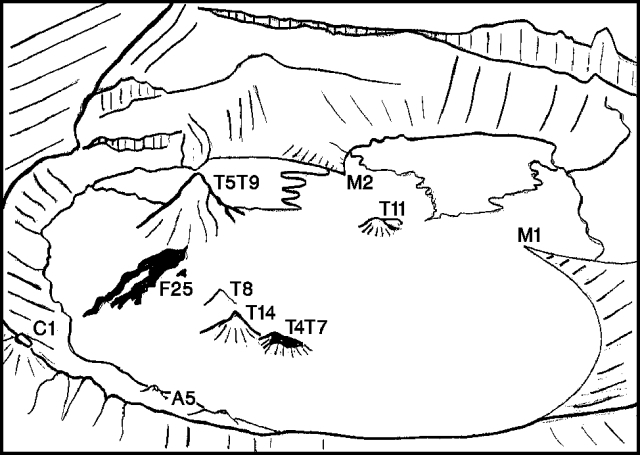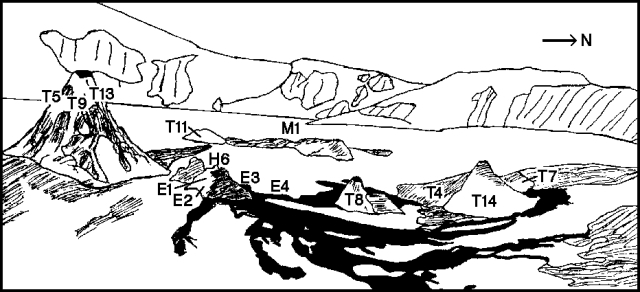Report on Ol Doinyo Lengai (Tanzania) — August 1991
Bulletin of the Global Volcanism Network, vol. 16, no. 8 (August 1991)
Managing Editor: Lindsay McClelland.
Ol Doinyo Lengai (Tanzania) Carbonatite lava production continues on crater floor
Please cite this report as:
Global Volcanism Program, 1991. Report on Ol Doinyo Lengai (Tanzania) (McClelland, L., ed.). Bulletin of the Global Volcanism Network, 16:8. Smithsonian Institution. https://doi.org/10.5479/si.GVP.BGVN199108-222120
Ol Doinyo Lengai
Tanzania
2.764°S, 35.914°E; summit elev. 2962 m
All times are local (unless otherwise noted)
Photographs taken . . . by D., M., and T. Peterson on 25 January showed few changes since late 1990. Lava flows of varying ages were evident on the crater floor, with the youngest (F25) extending N toward the crater wall from a hornito on the N flank of . . . T5/T9 (figure 22). Its dark brown color and clearly defined margins indicated that it may have been active during the Petersons' visit. Light gray-brown lava had spread from a source near vent T11, across the former saddle (M1M2) to the S wall of the crater, covering more than half of the floor of the former southern depression. Lava of similar age also covered much of the N part of the main crater.
M. Peterson returned . . . 29-30 March, and reported 10-15 minutes of lava production during the evening of the 30th from 2 or 3 vents on the N side of T5/T9, very close to the source of the freshest flow photographed on 25 January. A number of flows moved away from the vents, the longest advancing ~50 m. Flow widths averaged 1-2 m and thicknesses varied from 10 to 20 cm. Steam and sulfur fumes were issuing from several sources on the crater rim, walls, and floor. Older flows in the N part of the crater were dominantly pahoehoe but some aa lava was also observed. Flows entering the S depression were blocky and ~2/3 m thick.
 |
Figure 22. View SE across the crater floor of Ol Doinyo Lengai, 25 January 1991. A recent flow from vent T5/T9 is shown in black. Prepared by C. Nyamweru from a photo taken by the Peterson group. |
Little fresh lava was evident on the dominantly pale gray to white crater floor during a visit by Benoit Wangermez on 6 May. A slightly darker flow covered most of the southern depression, showing that lava had advanced S since January from a source slightly NW of T11. Small flows around the base of T5/T9 (active in late March) did not look very young. One new light-colored zone (at M2) appeared to be a vent, currently inactive, that had formed since March.
When T. Peterson arrived at the crater rim on 28 June at about 1000, lava was flowing W from a new vent (T18) W of T5/T9. Activity had subsided 30 minutes later, and the level of lava in the vent had fallen 5 m. Heat was rising from older vents (T5/T9 and T14), while T11 had partially collapsed and looked like a "sulfur cave." Lava flows on the crater floor ranged from dark (fresh) to almost white.
A group led by Luigi Cantamessa climbed to the summit on 12 July. No effusive activity was evident, but black to grayish flows [were] perhaps 1-2 days old . . . . Fumarolic activity occurred from some small hornitos. Many fissures were seen; one extended E-W, parallel to the former saddle dividing the main and southern craters, and cut across the W rim, but was not visible on the volcano's outer flank.
Eruptive activity was very minor . . . on 9 August between 1000 and 1400. Hot, fresh, dark gray natrocarbonatite lava was found near the H6 vent complex (figure 23). Water poured on the lava boiled violently. The extent of other fresh lava flows was similar to that observed 4 days later (see below). A small hornito on the S side of H6 ejected 2-3-mm droplets of spatter. A frozen, but still fresh lava pool ~4 m in diameter was found ~2 m below the average elevation of M1's crater floor (a group of tourists and a local guide reported that vents H6 and M1 had been active 2 days earlier). Vent T5/T9 emitted hot colorless gas, while T11 exhaled SO2. Radial fissures on the W flank of the crater produced almost pure (>95%) CO2, with some SO2. Holes ~0.5-1 m across on the crater's W rim released hot, humid air with no detectable SO2 or CO2. These holes contained a variety of water-loving plants such as moss and algae. Gas compositions were measured with Dräger tubes.
 |
Figure 23. Sketch map of the crater floor of Ol Doinyo Lengai, 13 August 1991. Fresh lava is shown in black. Courtesy of Alain Catté. |
Lava production from one vent complex was continuing during a summit climb by Alain Catté and others on 13 August. Irregular, weak, but clearly audible explosions occurred from the 4-5-m-high hornito complex H6, ejecting lava fragments horizontally to 10-15 m from two vents (E1 and E2). Weak effusive activity occurred from a site ([E4]) 5 m below the hornito complex. Young, chocolate-brown flows extended from its base in three directions atop older (>48 hours) whitish flows: ~10 m E; ~40 m NE; and > 100 m N, flowing around other small cones. Production of small flows accompanied vent E1's explosions from the initial observations at 0845 until its activity stopped at about 1000.
When clouds cleared at 1030, a very fluid lava flow 40-50 cm wide was emerging from neighboring vent E2. The flow quickly subdivided into many black lobes ~10 cm wide, with a consistency like lubricating oil. Within a few seconds, these formed channeled pahoehoe flows that turned to aa at their distal ends. Lava also formed tubes that carried it >100 m from the source. No lava temperatures were taken, but it was possible to place one's hand a few centimeters from an active flow, and to touch it after ~2 minutes of cooling. A cascade of lava ~10 cm wide began from a third vent (E3) on the hornito complex at about 1145. Vents E2 and E3 erupted simultaneously and showed parallel fluctuations in activity. Later . . . lava outflow from E2 occurred in a jet 2 m long.
At about noon, lava production resumed from the base of the hornito complex (at [E4]) bubbling out in a manner reminiscent of mud pots. It overflowed after ~45 minutes, gradually building a hornito that grew to 1 m height before activity ceased at about 1330. Above [E4], lava effusion from vent E3 stopped at 1230, emerging from a channel 2 m below in a violent, 3-m jet that reached the base of [E4], beginning to fill the area with lava. The outflow rate increased progressively, and lava had advanced 60 m W by the end of observations at about 1400. Lava production from the H6 complex had roughly quadrupled its size since . . . March.
Geological Summary. The symmetrical Ol Doinyo Lengai is the only volcano known to have erupted carbonatite tephras and lavas in historical time. The prominent stratovolcano, known to the Maasai as "The Mountain of God," rises abruptly above the broad plain south of Lake Natron in the Gregory Rift Valley. The cone-building stage ended about 15,000 years ago and was followed by periodic ejection of natrocarbonatitic and nephelinite tephra during the Holocene. Historical eruptions have consisted of smaller tephra ejections and emission of numerous natrocarbonatitic lava flows on the floor of the summit crater and occasionally down the upper flanks. The depth and morphology of the northern crater have changed dramatically during the course of historical eruptions, ranging from steep crater walls about 200 m deep in the mid-20th century to shallow platforms mostly filling the crater. Long-term lava effusion in the summit crater beginning in 1983 had by the turn of the century mostly filled the northern crater; by late 1998 lava had begun overflowing the crater rim.
Information Contacts: C. Nyamweru, St. Lawrence Univ; D. Peterson, M. Peterson, and T. Peterson, Arusha, Tanzania; B. Wangermez, Nairobi, Kenya; L. Cantamessa, Geo-decouverte, Switzerland; P. Vetsch, SVG, Switzerland; T. Dunai, R. Ragettli, K. Schenk-Wenger, and U. Ziegler, ETH Zürich, Switzerland; A. Catté, B. DeMarne, and P. Barois, LAVE.

